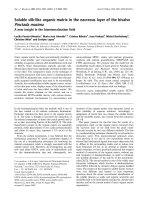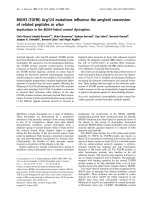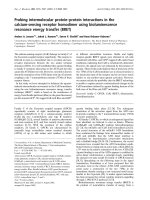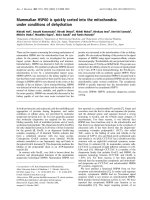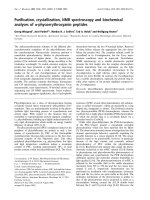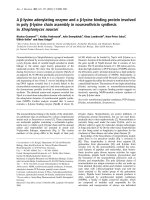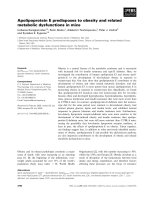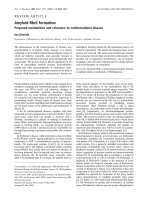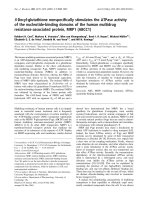Báo cáo y học: "Postictal psychosis: presymptomatic risk factors and the need for further investigation of genetics and pharmacotherapy" doc
Bạn đang xem bản rút gọn của tài liệu. Xem và tải ngay bản đầy đủ của tài liệu tại đây (242.65 KB, 6 trang )
BioMed Central
Page 1 of 6
(page number not for citation purposes)
Annals of General Psychiatry
Open Access
Case report
Postictal psychosis: presymptomatic risk factors and the need for
further investigation of genetics and pharmacotherapy
Eric M Morrow*
1
, Jennifer M Lafayette
1
, Edward B Bromfield
2
and
Gregory Fricchione
1
Address:
1
Department of Psychiatry, Massachusetts General Hospital, Boston, MA 02114, USA and
2
Division of Epilepsy and EEG, Department of
Neurology, Brigham and Women's Hospital, 75 Francis Street, Boston, MA 02115, USA
Email: Eric M Morrow* - ; Jennifer M Lafayette - ; Edward B Bromfield - ;
Gregory Fricchione -
* Corresponding author
Abstract
Background: Postictal psychosis (PIP), an episode of psychosis occurring after a cluster of
seizures, is common and may be associated with profound morbidity, including chronic psychosis.
Symptoms are often pleomorphic, involving a range of psychotic symptoms, including hallucinations
and disorders of thought. PIP is treatable and may be averted if presymptomatic risk factors are
considered in susceptible patients and treatment is initiated.
Case presentation: In this report, we present an illustrative case of PIP. The patient, Mr. R,
presented to our emergency room with delusions and disordered thought process following a
cluster of seizures. He recovered after admission, sedation and treatment with antipsychotic
medication.
Discussion: A list of presymptomatic risk factors is established based on review of current
literature. Identification of such risk factors may potentially help with prophylactic treatment;
however, little empirical research exists in this area and treatment guidelines are thus far largely
based on expert opinion. Further, while the neurobiology of schizophrenia is advancing at a rapid
pace, largely due to advances in genetics, the pathophysiology of PIP remains largely unknown.
Considering the progress in schizophrenia research in the context of the clinical features of PIP and
existing studies, potential neurobiological mechanisms for PIP are herein proposed, and further
genetic analyses, which may help identify those susceptible, are warranted.
Conclusion: While PIP is an important problem that may present first to general hospital
psychiatrists, as in the case presented, this topic is under-represented in the medical psychiatry
literature. As discussed in this article, further research is needed to develop presymptomatic
screens and treatment pathways to help prevent morbidity.
Background
Postictal psychosis (PIP) is characterized by an episode of
psychosis occurring within one week after a cluster of sei-
zures. PIP is common. In a study of inpatient video-elec-
troencephalographic monitoring, the annual incidence of
postictal psychotic events was estimated to be 6.4% [1].
Published: 21 July 2006
Annals of General Psychiatry 2006, 5:9 doi:10.1186/1744-859X-5-9
Received: 11 July 2005
Accepted: 21 July 2006
This article is available from: />© 2006 Morrow et al; licensee BioMed Central Ltd.
This is an Open Access article distributed under the terms of the Creative Commons Attribution License ( />),
which permits unrestricted use, distribution, and reproduction in any medium, provided the original work is properly cited.
Annals of General Psychiatry 2006, 5:9 />Page 2 of 6
(page number not for citation purposes)
The prevalence of PIP is difficult to measure; however, in
a study of greater than 100 outpatients with treatment
resistant partial epilepsy, the prevalence of having experi-
enced postictal psychotic symptoms was found to be 7%
[2]. While PIP is usually short-lived, with remission after
several days to weeks, chronic psychoses may develop
from recurrent episodes or even a single episode [3]. Psy-
chopathologic symptoms across cases are pleomorphic
[1,4]. Psychotic symptoms may include hallucinations,
including auditory or visual. Abnormalities of content of
thought, such as ideas of reference or delusions (including
paranoid, grandiose, somatic, religious or others) are
often present, as may be abnormalities of form of thought
(for example, thought blockage, loose associations or tan-
gentiality). Schneiderian First-rank symptoms have been
reported [1]. In a minority of cases, manic symptoms may
co-occur in the acute episode after the seizure cluster, yet
these symptoms generally are not of sufficient duration to
meet criteria for manic episode, while the psychotic symp-
toms more commonly persist [1,4]. Given this prevalence
and morbidity, assessing risk for PIP (or prompt recogni-
tion of symptoms) in patients who have had a cluster of
seizures may have major therapeutic implications. Expert
opinions suggest that episodes may be averted or short-
ened by introducing low-dose neuroleptics at the first sign
of psychosis or sleeplessness, which often precedes epi-
sodes; however, little empirical evidence exists in the liter-
ature on this topic. In some situations, the consultation
psychiatrist, or as in the case below, the emergency room
psychiatrist, are faced with the task of recognizing and
treating this condition. Despite the fact that PIP represents
25% of the psychoses of epilepsy (POE) [5,6], it is rela-
tively underrepresented in the psychiatric medicine litera-
ture. Here we describe a case which is remarkable for the
extent to which it demonstrates the classic features of PIP,
and it thereby may serve to review the diagnostic criteria,
known risk factors, and treatment supported by experts.
Recent insight into the genetics of primary psychotic dis-
orders such as schizophrenia may lead hypotheses into
the susceptibility and pathophysiology of PIP which is
also discussed herein. However, overall this article is
designed to point out the need for further research in both
pathophysiology and treatment of this common condi-
tion.
Case presentation
Mr. R, a 47 year-old right-handed male, presented to our
hospital, confused, with delusions of grandeur and ele-
vated mood. He was initially found wandering our hospi-
tal lobby at night somewhat bewildered and lethargic. Left
in the front drive of the hospital by a taxi cab, the patient
said that he had a "seizure attack." He was carrying multi-
ple bags as if he were on a trip. Shortly after being taken
to the Emergency Department (ED), Mr. R became agi-
tated, at which time he received intramuscular haloperi-
dol and lorazepam, and intravenous phenytoin. The
patient slept and an EEG was performed.
Information was gathered by telephone contact with the
patient's family, and we determined that Mr. R was mar-
ried and lived in a different city where he was stably
employed. The patient had a 4 year history of generalized
tonic-clonic (GTC) seizures, perhaps secondarily general-
ized, and thought to be related to a motor vehicle accident
with head trauma and loss of consciousness 11 years
prior. He also had a history of febrile convulsions as a
child, but there was no known history of CNS infection or
developmental delay. There was no family history of sei-
zures.
According to the patient's wife, Mr. R had a cluster of four
witnessed convulsive seizures four days prior to presenta-
tion. Behaviour noted prior to convulsions included "star-
ing, not answering, chewing, swallowing heavily, moving
both hands in a swimming motion or picking at things."
Following the four witnessed seizures, three days prior to
presentation in our hospital, the patient was brought to
his local hospital by his wife where he was admitted. Val-
proic acid was added to the patient's anti-epileptic regi-
men of oxcarbazepine. He had an approximately 24 hour
period of normal behaviour and was discharged. Two
days prior to presentation at our hospital, Mr. R had one
sleepless night. His wife described the patient's behaviour
as "hyper" and "strange". He then left his home unan-
nounced, taking belongings with him. In the 24 hours
prior to presenting at our hospital, Mr. R made numerous
telephone calls to family and friends around the country,
making it evident that he was traveling. His reported state-
ments contained delusions of grandeur and wealth, and
reflected impulsivity and poor judgments. This behaviour
represented a drastic departure from the Mr. R's baseline
according to his wife.
Other than the seizure disorder as stated above, past med-
ical history was non-contributory. He had no prior psychi-
atric history. Substance and alcohol use were not
significant. There was a notable family history of depres-
sion without suicidality. There were no known environ-
mental exposures. Mr. R was raised as a Christian, but he
did not participate in religious activities as an adult.
In the ED, the patient's vital signs, physical exam, cranial
nerve, motor and sensory examinations were all within
normal limits. On mental status examination after 12
hours in hospital, Mr. R was in his undergarments and a
hospital gown, sitting without an appropriate sense of
modesty. He was reading a copy of the Old Testament. He
was friendly, co-operative and jovial. His speech was
somewhat rapid but interruptible. He reported his mood
as "really good. Everyone thinks something is wrong
Annals of General Psychiatry 2006, 5:9 />Page 3 of 6
(page number not for citation purposes)
when you're really happy." His affect was bright and at
times even euphoric. His thought process was tangential
with loose associations, disorganized and at times diffi-
cult to follow. His thought content was notable for delu-
sions of grandeur and wealth with religious content, but
not of a bizarre nature. Hallucinations were denied and
not suspected by behaviour on exam. Mr. R described a
sense that he knew the examining clinician, stating "Are
you sure I haven't met you before?" His language was flu-
ent with normal naming and repetition. Cognitive exam
was notable for difficulty with tasks of attention. Review
of physical symptoms was notable for denial of macropsia
or micropsia, gustatory or olfactory hallucinations, or
stomach upset at the time of exam or at any time in the
course of his recent illness by report.
Laboratory values revealed normal basic chemistries
including liver function tests, coagulation tests, and CBC.
Urine and extended serum toxicology tests were negative.
Valproic acid level was 21 micrograms/milliliters. Serum
creatine kinase levels rose to 1830 U/L at 16 hours after
presentation then fell towards normal, with normal tro-
ponin levels. Serum prolactin levels were elevated to 20.4
ng/mL at 9 hours after presentation. Ammonia, vitamin
B12, serum folate, and thryroid measures were normal,
and RPR was non-reactive. ESR, ANA, and rheumatoid fac-
tor were within normal limits. Hepatitis C and B and HIV
serology were negative. Chest x-ray was normal. A lumbar
puncture was not performed.
Brain CT was within normal limits except for mildly
prominent ventricles. MRI of brain was notable for
encephalomalacic change within bilateral posterior fron-
tal and right parietal lobes, best seen on FLAIR sequences.
No abnormal contrast enhancing or mass lesions were
noted in the mesial temporal lobes. Multiple hyperintense
foci in deep and subcortical white matter were noted on
FLAIR bilaterally. Ventricles, sulci and cisterns were mildly
prominent for age and there was mild cerebral cortical
volume loss.
An electroencephalogram was obtained in the ED on pres-
entation shortly after receiving phenytoin, lorazepam and
haloperidol. Diffuse low amplitude slowing with fronto-
central predominance was observed, in addition to central
and symmetric spindles. No spikes or sharp waves were
seen.
Mr. R was admitted to inpatient psychiatry and treated
with antiepileptic and antipsychotic medicine. Oxcar-
bazepine was administered at a dose of 600 mg twice
daily, as was valproic acid at a dose of 500 mg three times
daily and 750 mg at night. Lorazepam was administered
at 1 mg three times daily for 3 days, then tapered. Olanza-
pine was used at a final dose of 15 mg daily. Disorganized
form of thought, delusional content, poor self care and
inappropriately bright affect remained until hospital day
8 but began to improve at this time. A repeat EEG was per-
formed on hospital day 5. Both drowsy and asleep EEGs
were without definitive evidence of epileptiform activity.
Brief periods of awake state showed an unsustained but
symmetric 8–10 Hz posterior rhythm. The patient was dis-
charged on hospital day twelve with significant improve-
ment in his mental status.
Discussion
Logsdail and Toone defined diagnostic criteria for PIP [4],
thereby distinguishing PIP from the other psychoses of
epilepsy, namely ictal and interictal psychosis. The patient
presented here meets these diagnostic criteria, which
include: 1) an episode of psychosis emerging within one
week after the return of normal mental function following
a seizure; 2) the episode length was between 24 hours and
3 months; 3) there was no evidence of anticonvulsant tox-
icity, a previous history of interictal psychosis, EEG evi-
dence of nonconvulsive status epilepticus, recent head
injury, or alcohol or drug intoxication. Though these cri-
teria may seem clear after the fact, diagnosis in the ED can
be difficult if the complete history is not known. Other life
threatening disorders that may lead to a change in mental
status such as acute intoxication or withdrawal, head inju-
ries, intracranial bleeding, infection and metabolic abnor-
malities must be ruled out.
In terms of DSM-IV [7] diagnostic criteria, the case pre-
sented here meets criteria for a Psychotic Disorder with
Delusions Due to a General Medical Condition, specifi-
cally epilepsy. In general, PIP is meant to be categorized
under this diagnosis. The patient would not be classified
as a Delirium as during the 8–10 day period during which
his delusions persisted, he was without changes in con-
sciousness. In addition, while the case presented here has
some qualities of Dissociative Fugue, such as unexpected
travel away from home, the patient was without amnesia
or identity confusion, and this diagnosis is only applied in
the absence of known medical causes. For this reason also,
Brief Psychotic Disorder is excluded. Because the patient
described here presented with manic symptoms in addi-
tion to psychotic symptoms, Mood Disorder with Manic
Features Due to General Medical Condition is an impor-
tant consideration. Because this patient had a sustained
period (over one week) where delusions persisted in the
absence of other prominent manic symptoms, we favour
the diagnosis of Psychotic Disorder, over Mood Disorder
due to General Medical Condition. Mood disorders, par-
ticularly depression, associated with epilepsy (and includ-
ing in the postictal state [1]) are an important problem
with profound morbidity; however, this topic is beyond
the scope of this review and has been reviewed recently
elsewhere [8].
Annals of General Psychiatry 2006, 5:9 />Page 4 of 6
(page number not for citation purposes)
Several studies, generally conducted in inpatient video-
EEG monitoring units, have characterized risk factors for
susceptibility to developing PIP. The patient presented
here typifies many of these risk factors (Table 1). Patients
who have had a cluster of seizures are at risk [9]. Many
studies have suggested that patients with GTC seizures or
partial seizures secondarily generalized are at increased
risk [10,11]. While there is a variation in the age of onset
of epilepsy, there is a trend toward later onset epilepsy and
a duration of 5 to 10 years between the onset of chronic
epilepsy and PIP [9,11]. Prior episodes of PIP are consid-
ered a risk factor, as are prior psychiatric hospital admis-
sions [1,4,10,12]. PIP may be recurrent and some studies
suggest that in select cases psychosis may not resolve
entirely between episodes [3]. Family history of mood dis-
order (as in our case) has been implicated [13]. Family
history of psychosis has been noted in one study [14].
However, in two studies psychosis was not statistically dif-
ferent between patients with and without family history
[1,4]. Despite these equivocal data, given that these stud-
ies are small and that overwhelming evidence supports an
elevated recurrence risk for primary psychotic disorders,
we believe that family history of psychosis is a likely risk
factor in addition to a family history of mood disorders.
There is not strong evidence implicating gender. While
some studies report more cases in men than in women
[1,11], these studies are too small for statistical signifi-
cance. A larger study is required prior to considering male
gender as a strong, independent risk factor. An absence of
history of febrile seizures has been reported in some stud-
ies [9] although this has not been found consistently [10].
A history of low intellectual function has been noted as a
risk factor in some studies [14].
Interestingly, bilateral cerebral abnormalities have been
commonly reported in patients with PIP. Several studies
have reported bilateral temporal independent discharges
in patients with PIP [4,9,10,15]. In a careful study by
Devinsky et al., patients with PIP had evidence of bilateral
cerebral injury or dysfunction more frequently than con-
trol epilepsy patients [10]. There was a significantly
greater rate of history of encephalitis or head trauma. Such
patients often have bilateral frontal and temporal cerebral
damage. This pattern of neuropathology was noted on
MRI with the patient presented here. While EEG evidence
of a seizure focus was not obtained in our patient, the lip-
smacking and automatisms preceding convulsions, as
described by the wife, are highly suggestive of temporal
lobe seizures which become secondarily generalized.
Interestingly, a SPECT study of patients with TLE and PIP
was remarkable for bifrontal and bitemporal hyperper-
fusion patterns [16], suggesting the bilaterality may be an
important pathological feature of PIP.
While no prospective trials of treatment, symptomatic or
prophylactic, have been published, treatment recommen-
dations have emerged based on expert opinion and have
appeared in the neurology literature [1,6,15]. Agents and
doses, therefore, have been generally chosen based on
studies and experience with acute psychosis. Multiple
authors encourage vigilant monitoring of patients with
risk factors for PIP after a cluster of seizures. In such
patients, low dose antipsychotic medication (2–4 mg of
risperidone) is recommended in the early stages after the
emergence of symptoms [6]. As patients are often neu-
roleptic-naïve, starting at low doses may be prudent and
such doses are often sufficient. Most authors favour atyp-
ical antipsychotics; however, some literature describes
using typicals, such as haloperidol (2–5 mg) with success
[1]. Some authors even argue that pharmacotherapy may
be instituted prior to the advent of psychosis, and instead
with the emergence of sleeplessness which can portend a
psychotic episode [6]. In patients who have chronic epi-
lepsy and a history of recurrent PIP, Kanner has suggested
that treatment may be considered after the cluster of sei-
zures alone [6]. Patient and family education may be crit-
ical if the seizure cluster occurs in the outpatient setting.
Although no studies have been performed specifically to
assess longitudinal treatment guidelines, experts and the
available literature recommend that patients should not
remain on antipsychotic medication. Instead the medi-
cine may be prescribed for 2 to 5 days if the episode is
Table 1: Risk Factors for Postictal Psychosis
A cluster of seizures.
Insomnia within 1 week, but particularly within 1–3 days.
Epilepsy of > 10 years duration.
Generalized tonic-clonic seizures or complex partial secondarily generalized.
Prior episodes of PIP.
Prior psychiatric hospitalizations or history of psychosis.
Bilateral independent seizure foci (particularly temporal).
History of traumatic brain injury or encephalitis.
Low intellectual function.
In a patient with chronic epilepsy with the above risk factors, patients should be monitored vigilantly and low dose antipsychotic should be
considered at the first signs of insomnia, or the earliest signs of psychosis or thought disorder. If patient has a history of recurrent PIP,
antipsychotics may be considered prophylatically after seizure cluster.
Annals of General Psychiatry 2006, 5:9 />Page 5 of 6
(page number not for citation purposes)
averted, or up to 6 months if a full-blown episode occurs,
as in our patient, and then may be tapered. Because antip-
sychotics may lower the seizure threshold, it may be nec-
essary to increase doses of antiepileptic medicines. Again,
readers should be cautioned that prospective trials assess-
ing these treatment strategies have not yet emerged in the
literature. One small case series, for example, suggests that
sedation, as opposed to specifically antipsychotic treat-
ment, is sufficient to ward off PIP; however, this study is
underpowered and retrospective [17]. Further research
specifically targeting treatment and prevention of PIP is
important, as some data suggest that PIP may be pre-
vented and conversion to chronic psychosis may be at risk
[3]. For example, in this case, could Mr. R's episode of psy-
chosis have been averted? Potentially yes, if he had been
administered a dose of neuroleptic during the episode of
sleeplessness which preceded his psychosis.
The pathophysiologic mechanism of PIP is unknown.
One hypothesis is that PIP represents a psychic Todd's
paralysis [15,18]. In one of the few studies on the patho-
physiology of PIP, Fong et al. observed lateral temporal
hyperperfusion as assessed by SPECT in postictal psycho-
sis [19], and they thereby argue against the Todd's paraly-
sis hypothesis which might predict hypoperfusion. The
temporal emergence of PIP after a lucid period following
seizures may also be inconsistent with the decrescendo
course of Todd's phenomena [20]. Therefore, a role for
Todd's phenomena remains controversial, yet given our
limited knowledge of the etiology of psychosis, a compo-
nent of a Todd's phenomenon may not be entirely
excluded.
By considering the generally common clinical features of
PIP, and calling on studies of the pathophysiology of
schizophrenia, speculative models of the neurobiology of
PIP may be constructed, and thereby tested in future stud-
ies. In schizophrenia, it is widely believed that mesolim-
bic dopamine input to the nucleus accumbens, as well as
the amygdala and hippocampus, is related to the acute,
positive symptoms of psychosis, and that this is the site of
action of antipsychotic medicine (see [21] and references
therein). Further, a cortico-hippocampal loop may be dis-
rupted which results in excess subcortical dopamine. Neu-
roimaging studies widely support hypofunction
(generally bilateral) of the frontal cortex in schizophrenia,
particularly in the region of the dorsolateral prefrontal
cortex [22], while hyperactivity, has been noted in the hip-
pocampus [23]. One may speculate that in PIP, there
exists bilateral hypofunction of the frontal and/or other
multimodal association cortex. The fact that PIP is seen
commonly in cases of bilateral dysfunction suggests this,
as well as the loss of cortical inhibition of structures such
as hippocampus and accumbens. At least in macaque, pre-
frontal cortical projections have been observed to project
bilaterally [24,25], thereby, unilateral lesions would not
be sufficient for loss of cortical inhibition. Further, this
model would suppose that the cluster of generalized sei-
zures commonly seen in advance of an episode of PIP
would uncover the deficits of bilateral cortical lesions seen
in head trauma or diffuse cortical damage seen post-
encephalitis. For example, in the MRI in the current case,
bilateral lesions were observed in regions of frontal cortex
likely to be multimodal association cortex (see case
above). These lesions are consistent with head trauma
known from the history to precede the emergence of the
seizure disorder. In addition, generalized cerebral cortical
volume loss was noted which could contribute to further
generalized loss of cortical inhibition. Also as in schizo-
phrenia, hyperfunction of the temporal cortex (more spe-
cifically hippocampus) is likely. This follows from the
observation that the majority of PIP occurs in patients
with TLE [4,9,10,15].
In order to prevent cases of PIP and reduce morbidity, fur-
ther research is warranted. A recent investigation of
interictal psychosis has found an increase in psychotic
symptoms in patients with low serum folate and/or high
homocysteine levels [26]. In addition, given the recent
emergence of putative schizophrenia susceptibility genes,
genetic risk may be examined (reviewed in [27]). For
example, the val158met polymorphism in the COMT
gene, which is associated with prefrontal dysfunction in
schizophrenia [28], could be assessed for a possible role
in psychosis in patients with epilepsy. In addition to
COMT, several other putative risk haplotypes have
emerged in the last 5 years including in genes such as
DISC1 and Neuregulin [27]. As the field of schizophrenia
genetics works to make these susceptibility loci more
definitive, they may also be tested for a potential role in
predisposing to PIP. Such studies could draw the field of
epilepsy further into the convergence of other neuroscien-
tific areas related to psychosis, and in the future provide
further clinical criteria for assessing risk.
Conclusion
Postictal psychosis (PIP) is common and may be associ-
ated with profound morbidity. PIP occurs after a cluster of
seizures and often after an episode of insomnia. Risk fac-
tors include longstanding generalized tonic-clonic sei-
zures or complex partial seizures that are secondarily
generalized. A prior episode of PIP is a strong risk factor,
as well as prior psychiatric history, in particular a history
of psychosis. Bilateral temporal seizure foci are common
in PIP, as is a history of traumatic brain injury, encephali-
tis or low intellectual function (which may reflect bilateral
cortical compromise). This condition may be averted with
prudent treatment of susceptible patients with prophylac-
tic antipsychotic and/or sedative medicines. Therefore,
Publish with BioMed Central and every
scientist can read your work free of charge
"BioMed Central will be the most significant development for
disseminating the results of biomedical research in our lifetime."
Sir Paul Nurse, Cancer Research UK
Your research papers will be:
available free of charge to the entire biomedical community
peer reviewed and published immediately upon acceptance
cited in PubMed and archived on PubMed Central
yours — you keep the copyright
Submit your manuscript here:
/>BioMedcentral
Annals of General Psychiatry 2006, 5:9 />Page 6 of 6
(page number not for citation purposes)
psychiatrists should be cognizant of risk factors and vigi-
lant when evaluating susceptible patients.
Competing interests
The author(s) declare that they have no competing inter-
ests.
Authors' contributions
EMM, GF and EBB reviewed the existing literature. EMM
drafted the manuscript which was edited GF, EBB, and
JML. JML contributed to the thoughtful care of the patient
presented, reviewed the manuscript and contributed to
the writing. All authors approved the final manuscript.
Acknowledgements
EMM would like to thank Drs. Bernard Chang and Josh Roffman for careful
review of the manuscript. Thank you also to Drs. Amy Taylor and John Mat-
thews who also contributed thoughtfully to the care of this patient.
References
1. Kanner AM, Stagno S, Kotagal P, Morris HH: Postictal psychiatric
events during prolonged video-electroencephalographic
monitoring studies. Arch Neurol 1996, 53(3):258-263.
2. Kanner AM, Soto A, Gross-Kanner H: Prevalence and clinical
characteristics of postictal psychiatric symptoms in partial
epilepsy. Neurology 2004, 62(5):708-713.
3. Tarulli A, Devinsky O, Alper K: Progression of postictal to
interictal psychosis. Epilepsia 2001, 42(11):1468-1471.
4. Logsdail SJ, Toone BK: Post-ictal psychoses. A clinical and phe-
nomenological description. Br J Psychiatry 1988, 152:246-252.
5. Dongier S: Statistical study of clinical and electroencephalo-
graphic manifestations of 536 psychotic episodes occurring
in 516 epileptics between clinical seizures. Epilepsia 1959,
1:117-142.
6. Kanner AM: Psychosis of Epilepsy: A Neurologist's Perspec-
tive. Epilepsy Behav 2000, 1(4):219-227.
7. American Psychiatric Association., American Psychiatric Association.
Task Force on DSM-IV: Diagnostic and statistical manual of
mental disorders : DSM-IV-TR. 4th edition. Washington, DC:
American Psychiatric Association; 2000.
8. Kanner AM: Depression in epilepsy: a neurobiologic perspec-
tive. Epilepsy Curr 2005, 5(1):21-27.
9. Umbricht D, Degreef G, Barr WB, Lieberman JA, Pollack S, Schaul N:
Postictal and chronic psychoses in patients with temporal
lobe epilepsy. Am J Psychiatry 1995, 152(2):224-231.
10. Devinsky O, Abramson H, Alper K, FitzGerald LS, Perrine K, Cal-
deron J, Luciano D: Postictal psychosis: a case control series of
20 patients and 150 controls. Epilepsy Res 1995, 20(3):247-253.
11. Liu HC, Chen CH, Yeh IJ, Sung SM: Characteristics of postictal
psychosis in a psychiatric center. Psychiatry Clin Neurosci 2001,
55(6):635-639.
12. Adachi N, Kato M, Sekimoto M, Ichikawa I, Akanuma N, Uesugi H,
Matsuda H, Ishida S, Onuma T: Recurrent postictal psychosis
after remission of interictal psychosis: further evidence of
bimodal psychosis. Epilepsia 2003, 44(9):1218-1222.
13. Alper K, Devinsky O, Westbrook L, Luciano D, Pacia S, Perrine K,
Vazquez B: Premorbid psychiatric risk factors for postictal
psychosis. J Neuropsychiatry Clin Neurosci 2001, 13(4):492-499.
14. Adachi N, Matsuura M, Hara T, Oana Y, Okubo Y, Kato M, Onuma T:
Psychoses and epilepsy: are interictal and postictal psycho-
ses distinct clinical entities? Epilepsia 2002, 43(12):1574-1582.
15. Savard G, Andermann F, Olivier A, Remillard GM: Postictal psycho-
sis after partial complex seizures: a multiple case study. Epi-
lepsia 1991, 32(2):225-231.
16. Leutmezer F, Podreka I, Asenbaum S, Pietrzyk U, Lucht H, Back C,
Benda N, Baumgartner C: Postictal psychosis in temporal lobe
epilepsy. Epilepsia 2003, 44(4):582-590.
17. Lancman MECW, Asconapé JJ, Penry JK: Clinical management of
recurrent postictal psychosis. J Epilepsy 1994, 7:47-51.
18. Fong GC, Fong KY, Mak W, Tsang KL, Chan KH, Cheung RT, Ho SL:
Postictal psychosis related regional cerebral hyperfusion. J
Neurol Neurosurg Psychiatry 2000, 68(1):100-101.
19. Fong GC, Ho WY, Tsoi TH, Fong KY, Ho SL: Lateral temporal
hyperperfusion in postictal psychosis assessed by 99mTc-
HMPAO SPECT. Neuroimage 2002, 17(3):1634-1637.
20. Boylan LS: Postictal psychosis related regional cerebral hyper-
fusion. J Neurol Neurosurg Psychiatry 2001, 70(1):137-138.
21. Svensson TH: Dysfunctional brain dopamine systems induced
by psychotomimetic NMDA-receptor antagonists and the
effects of antipsychotic drugs. Brain Res Brain Res Rev 2000,
31(2–3):320-329.
22. Weinberger DR, Egan MF, Bertolino A, Callicott JH, Mattay VS, Lipska
BK, Berman KF, Goldberg TE: Prefrontal neurons and the genet-
ics of schizophrenia. Biol Psychiatry 2001, 50(11):825-844.
23. Heckers S: Neuroimaging studies of the hippocampus in schiz-
ophrenia. Hippocampus 2001, 11(5):520-528.
24. McGuire PK, Bates JF, Goldman-Rakic PS: Interhemispheric inte-
gration: I. Symmetry and convergence of the corticocortical
connections of the left and the right principal sulcus (PS) and
the left and the right supplementary motor area (SMA) in
the rhesus monkey. Cereb Cortex 1991, 1(5):390-407.
25. Preuss TM, Goldman-Rakic PS: Crossed corticothalamic and tha-
lamocortical connections of macaque prefrontal cortex. J
Comp Neurol 1987, 257(2):269-281.
26. Monji A, Yanagimoto K, Maekawa T, Sumida Y, Yamazaki K, Kojima
K: Plasma folate and homocysteine levels may be related to
interictal "schizophrenia-like" psychosis in patients with epi-
lepsy. J Clin Psychopharmacol 2005, 25(1):3-5.
27. Harrison PJ, Weinberger DR: Schizophrenia genes, gene expres-
sion, and neuropathology: on the matter of their conver-
gence. Mol Psychiatry 2005, 10(1):40-68. image 45
28. Egan MF, Goldberg TE, Kolachana BS, Callicott JH, Mazzanti CM,
Straub RE, Goldman D, Weinberger DR: Effect of COMT Val108/
158 Met genotype on frontal lobe function and risk for schiz-
ophrenia. Proc Natl Acad Sci USA 2001, 98(12):6917-6922.
